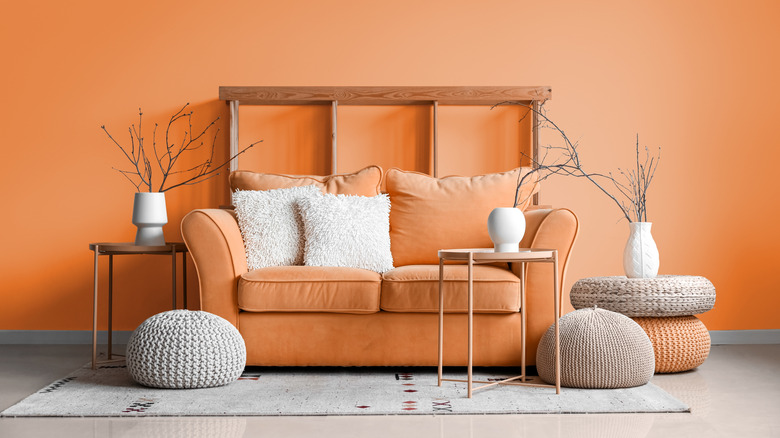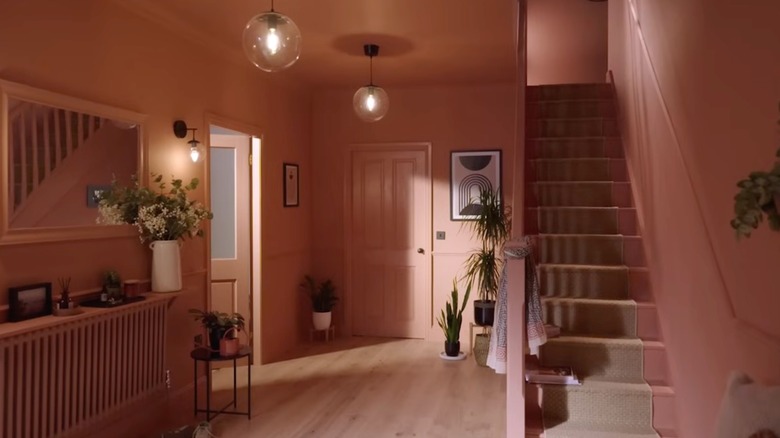Color Capping Vs Color Drenching: What's The Difference?
In the world of interior design, a color palette can make or break a room's aesthetic, and no decision feels as daunting as a painting project. Not only is it difficult to choose the perfect color, but paint trends change quickly, and a lot of time and energy goes into painting a room, which is work that's not easily undone. Two trends have recently taken center stage when it comes to interior paint jobs — color capping and color drenching. While these trends both involve painting the ceiling, they take different approaches to incorporating color and deliver contrasting moods in the process. Popular amongst interior designers, any homeowner keeping up on trends should learn the difference between color capping and color drenching to learn how to paint their home like a professional.
Color capping is the practice of painting just the ceiling or upper portion of the wall in a contrasting or complementary color to the lower wall. It is literally like putting a cap on the room to create a sense of structure. Color drenching does the opposite, and immerses an entire room in one single color — the walls, ceiling, trim, and even sometimes furniture. Both trends celebrate the emotional power of color in different ways. If you're thinking of giving them a try, let's first dig into how they work so you can decide if it's time for you to cap or drench your own home in your favorite colors.
How color capping elevates the drama
If you are looking for wall painting ideas to spruce up your home, color capping is a great way to add visual interest to a room without overwhelming it — but it needs to be done right. The key is to choose two or three hues from the same family that can add a gradient effect to your room. One way to use this technique would be to paint your ceiling a darker shade than the walls to create a cocoon-like feeling. This effect is perfect for making your bedroom feel cozy or your dining room more intimate. On the other hand, you can add a lighter or brighter color to the ceiling, which helps draw the eye upward, and makes your ceilings appear higher and your room more open.
This trend is popular because it defines your walls depths and adds visual movement to the room, especially in areas of your home that lack molding or other eye-catching design details. It's also a more cost-effective way to experiment with bold colors without committing to a full renovation. Another benefit of color capping is how easily it can be incorporated into any type of design. For example, it can easily be added to minimalist spaces and provide a little pop of sophistication without pulling focus from the overall aesthetic.
How color drenching calms your space
The opposite of color capping, color drenching embraces only one color, which blurs lines between walls and creates a seamless effect that envelops the whole room. Whatever shade you choose, whether it's bold or more neutral, color drenching's main purpose is to make a statement in any room you use it in. Designers love it for its maximalist appeal, bringing playfulness and character to a space without the need to spend a lot of money. But the benefits go beyond aesthetics, with some sources crediting the psychological benefits of viewing the uninterrupted lines in color drenching, saying it also creates a calm and tranquil space.
At the end of the day, choosing between the two depends on how you want your room to feel. Of course we all want to avoid the mistakes everyone makes when painting their home, and choosing the right option is key. If you love the concept of contrast, or just want to test a bold color of paint, color capping is a great way to try it out. If you want a high-impact and immersive look, you might try color drenching instead. No matter what you choose, these trends are probably going to stick around in the design world for awhile. So head to your nearest paint store and make your decision — will you cap your room with color or drench your space in it?


